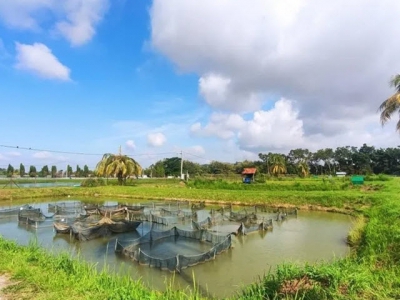Researchers make tilapia lake virus breakthrough

The possibility of breeding tilapia that are resistant to tilapia lake virus (TiLV) is one step closer, thanks to a genomic research breakthrough.
Scientists analysed the genome of almost 1,000 fish from a pond that had experienced an outbreak of tilapia lake virus. Photo: Mahirah Mahmuddin, WorldFish
A new study, led by the Roslin Institute and WorldFish, has found that a specific region in the genome of Nile tilapia – a key aquaculture species that is worth nearly $10 billion globally – has a major effect on mortality levels during an outbreak of TiLV.
They found that fish with specific genetic variants in this region were substantially less likely to die in an outbreak of the virus than fish without these variants. Survival rates improved by approximately one-third, the scientists observed.
By selecting parent fish for breeding based on these variants, tilapia strains with innate resistance can be developed. This will reduce the number of outbreaks and mortality rate of TiLV, which is one of the biggest threats to tilapia aquaculture, with mortalities up to 90 per cent and for which vaccines are not yet available.
“Tilapia lake virus can cause mass mortality to farmed Nile tilapia, which has major negative impacts for farmers and food security in many countries. Our results provide a clear route to selecting fish with improved genetic resistance to TiLV, with major potential to help tackle this devastating virus,” said Professor Ross Houston, from Roslin Institute, in a press release.
“Breeders will be able to select the best candidates for resistance to tilapia lake virus by marker-assisted selection, generating new strains of Nile tilapia with enhanced resistance. Interestingly, we also showed that this selection won’t have any negative impact on the fish harvest weight,” added his colleague, Dr Agustin Barria.
In the study, scientists analysed the genome of almost 1,000 fish from a pond that had experienced an outbreak of TiLV.
Comparing the genomes of fish that survived the outbreak with fish that did not enabled scientists to find the region in the genome containing variants associated with survival.
The average survival rate of tilapia with the favourable variants was 32 per cent higher than that of fish with none of the variants, the scientists found.
“This information will be invaluable in creating resilient tilapia breeds that can help maintain production of fish in the face of increasing disease risks that threaten food security in many parts of the world. WorldFish plans to incorporate TiLV resistance in the new strains of genetically improved farmed tilapia (GIFT) we are developing,” said Professor John Benzie, from WorldFish.
The study, published in the journal Heredity, was funded by the CGIAR Research Program on Fish Agri-Food Systems (FISH) and the Biotechnology and Biological Sciences Research Council, part of UK Research and Innovation.
Related news
 Hoa Binh produces up to 3,880 tonnes of fish in six months
Hoa Binh produces up to 3,880 tonnes of fish in six months Hoa Binh reported total fish output of 958 tonnes in May, of which 150 tonnes from fishing and 808 tonnes from fish farms.
 US announces final results of POR16 for Vietnamese tra, basa fish
US announces final results of POR16 for Vietnamese tra, basa fish The US Department of Commerce (DOC) has announced the final results of the 16th period of review (POR16) for the period from August 1
 Researchers launch lumpfish welfare tool
Researchers launch lumpfish welfare tool A new tool that fish farmers can use to improve the welfare of lumpfish has been developed by researchers at the University of Stirling.